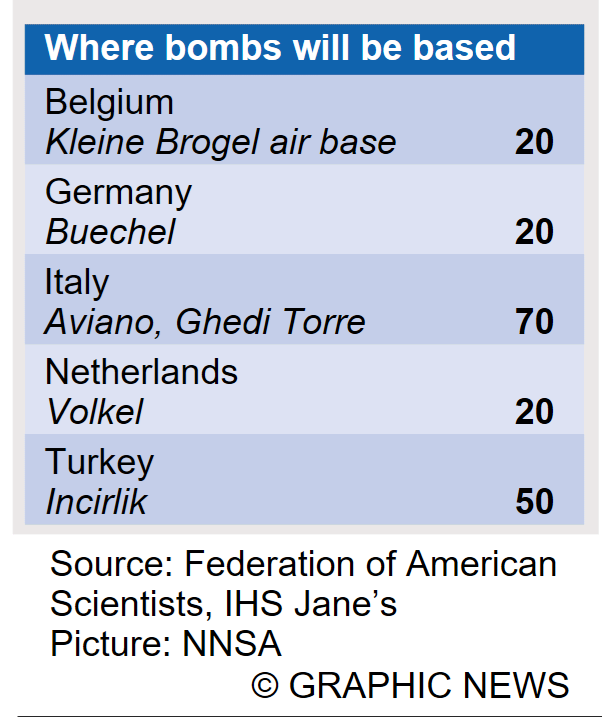It looks like you're using an Ad Blocker.
Please white-list or disable AboveTopSecret.com in your ad-blocking tool.
Thank you.
Some features of ATS will be disabled while you continue to use an ad-blocker.
1
share:
Curious enough I cannot find a report on this at abovetopsecret.com, so let's give it a go...
From nnsa.energy.gov
"Full scale production" does sound like someone is still angry at its neighbor and wants to blow its face to pieces. Oh boy, another teenage drama...
"Allies and partners"??? Did you just said that you again plan to export that havoc weaponry and lead your teenage war at someone's else house???
Some people have no shame...
From nnsa.energy.gov
WASHINGTON – The Department of Energy’s National Nuclear Security Administration (DOE/NNSA) announced that they recently formally authorized the production engineering phase of its B61-12 warhead life extension program (LEP). This important milestone comes after four years of work in the development-engineering phase of the program, and marks the final development phase prior to production. The first production unit (FPU) of this weapon is planned for Fiscal Year 2020, followed by full-scale production.
"Full scale production" does sound like someone is still angry at its neighbor and wants to blow its face to pieces. Oh boy, another teenage drama...
The B61-12 LEP is a joint NNSA and United States Air Force (USAF) program that preserves a critical element of the U.S. nuclear triad and the extended deterrent. The LEP refurbishes both nuclear and non-nuclear components to extend the bomb’s service life while improving its safety, security, and reliability to meet long standing material requirements. The LEP will reuse or remanufacture existing components to the maximum extent possible. The B61-12 will replace the existing B61-3, -4, -7, and -10 bombs.
“These life extension programs directly support President Obama’s directive to maintain a safe, secure, and effective nuclear deterrent, while reducing the size of the stockpile,” said Secretary of Energy Ernest Moniz. “Once completed, the B61-12 LEP will allow for the retirement of the B83-1—the last megaton-class weapon in America’s nuclear arsenal—while supporting the nation’s continued commitment to our national security and that of our allies and partners.”
"Allies and partners"??? Did you just said that you again plan to export that havoc weaponry and lead your teenage war at someone's else house???
Some people have no shame...
For the curious:


edit on 31-8-2017 by Argentbenign because: pic
a reply to: Argentbenign
Nuclear weapons in the form of gravity bombs are obsolete.
Lets see...
Shows up late pounds rubble.
Shows up on time gets shot down 'delivering' weapon.
Gets nuked by the other side before even taking off.
What other scenarios are there?
Nuclear weapons in the form of gravity bombs are obsolete.
Lets see...
Shows up late pounds rubble.
Shows up on time gets shot down 'delivering' weapon.
Gets nuked by the other side before even taking off.
What other scenarios are there?
edit on 31-8-2017 by intrptr because: spelling
a reply to: Argentbenign
Seems like nukes will be obsolete when swarm drones can and will take out any target anywhere. And do it on the cheap, compared to the nukes.
Seems like nukes will be obsolete when swarm drones can and will take out any target anywhere. And do it on the cheap, compared to the nukes.
(post by roguetechie removed for a manners violation)
new topics
-
Pure Love is simple.
Philosophy and Metaphysics: 10 minutes ago -
Interesting timing 40 monkeys flee medical lab in US
Diseases and Pandemics: 33 minutes ago -
All Talk No Walk Celebrities Blowing Smoke
US Political Madness: 2 hours ago -
Arizona and Nevada Called for Trump – Giving Trump 312 Electoral Votes
2024 Elections: 2 hours ago -
A question about abortion and the states
US Political Madness: 5 hours ago -
What shenanigans are at play with the house races?
2024 Elections: 6 hours ago -
Young People and Social Media
Social Issues and Civil Unrest: 9 hours ago
top topics
-
DOJ moving to wind down Trump criminal cases before he takes office
Mainstream News: 16 hours ago, 13 flags -
Young People and Social Media
Social Issues and Civil Unrest: 9 hours ago, 10 flags -
What shenanigans are at play with the house races?
2024 Elections: 6 hours ago, 10 flags -
Arizona and Nevada Called for Trump – Giving Trump 312 Electoral Votes
2024 Elections: 2 hours ago, 8 flags -
A question about abortion and the states
US Political Madness: 5 hours ago, 7 flags -
All Talk No Walk Celebrities Blowing Smoke
US Political Madness: 2 hours ago, 6 flags -
DC Votes
US Political Madness: 15 hours ago, 5 flags -
Interesting timing 40 monkeys flee medical lab in US
Diseases and Pandemics: 33 minutes ago, 5 flags -
Pure Love is simple.
Philosophy and Metaphysics: 10 minutes ago, 0 flags
active topics
-
Labour MP Mike Amesbury Repeatedly Punches Man to the Ground
Politicians & People • 15 • : gortex -
All Talk No Walk Celebrities Blowing Smoke
US Political Madness • 28 • : Vermilion -
Interesting timing 40 monkeys flee medical lab in US
Diseases and Pandemics • 3 • : Ravenwatcher -
Arizona and Nevada Called for Trump – Giving Trump 312 Electoral Votes
2024 Elections • 14 • : WeMustCare -
Pure Love is simple.
Philosophy and Metaphysics • 0 • : BrotherKinsMan -
A question about abortion and the states
US Political Madness • 26 • : Shoshanna -
What shenanigans are at play with the house races?
2024 Elections • 23 • : xuenchen -
The Acronym Game .. Pt.4
General Chit Chat • 916 • : tinkerbell99 -
-@TH3WH17ERABB17- -Q- ---TIME TO SHOW THE WORLD--- -Part- --44--
Dissecting Disinformation • 3164 • : angelchemuel -
On Nov. 5th 2024 - AMERICANS Prevented the Complete Destruction of America from Within.
2024 Elections • 88 • : SideEyeEverything1
1
